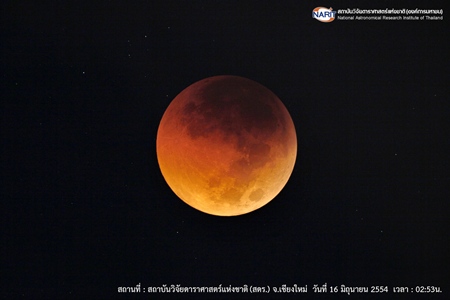Locally, clouds shorten viewing time
Thailand last week was witness to a rare celestial treat: the year’s first total eclipse of the moon.
Dr. Saran Posayajinda, deputy chief of Thailand’s National Astronomical Research Institute, said that the earth’s shadow began to pass over the moon at 01:22:37 a.m. on June 16 (Thailand time).
Totality began at 02:22:11 a.m. local time and lasted until 04:03:22 a.m., and with a duration of over 1 hour 40 minutes, it was the longest lunar eclipse since July 2000 when it lasted 7 minutes longer.
 This photo released by NARIT (National Astronomical Research Center of Thailand) shows the fiery red moon as seen from Chiang Mai during the full lunar eclipse June 16.
This photo released by NARIT (National Astronomical Research Center of Thailand) shows the fiery red moon as seen from Chiang Mai during the full lunar eclipse June 16.
The lunar spectacle was also visible from start to finish from eastern Africa, central Asia, the Middle East and western Australia – weather permitting. Locally, the weather didn’t cooperate, but an occasional break in the clouds did allow for brief glimpses of the fiery red moon.
The full moon normally glows from reflected sunlight. A total lunar eclipse occurs when the moon glides through the long shadow cast by the Earth and is blocked from the sunlight that illuminates it.
As the moon plunges deeper into the Earth’s shadow, the disk appears to gradually change color, turning from silver to orange or red. This is because some indirect sunlight still reaches the moon after passing through the Earth’s atmosphere, which scatters blue light. Only red light strikes the moon, giving it an eerie crimson hue. The exact shade the moon takes depends on how much dust and clouds are in the atmosphere during the eclipse.
Since the moon passed close to the center of the Earth’s shadow, the total eclipse phase was longer than usual, said NASA eclipse expert Fred Espenak at the Goddard Space Flight Center in Maryland.
Unlike solar eclipses, lunar eclipses are safe to watch with the naked eye.
The next total lunar eclipse will fall on Dec. 10 with best viewing from Asia and Australia. The moon will be completely blotted out for 51 minutes.
Online: Eclipse information: http://eclipse.gsfc.nasa.gov/eclipse.html




